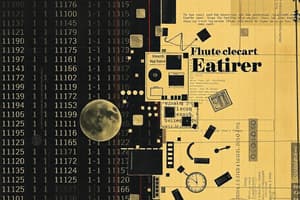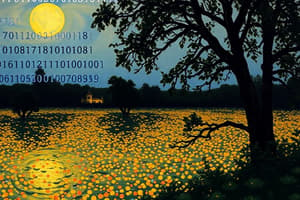Podcast
Questions and Answers
What is the primary role of a bit in computing?
What is the primary role of a bit in computing?
- It can represent 16 different values.
- It can hold a value of 0 or 1. (correct)
- It is used to represent a complete character of data.
- It is the largest unit of data.
How many bits are there in one byte?
How many bits are there in one byte?
- 10
- 8 (correct)
- 4
- 6
What is a nibble composed of?
What is a nibble composed of?
- 2 bits
- 16 bits
- 4 bits (correct)
- 8 bits
In the binary numbering system, what does each bit represent?
In the binary numbering system, what does each bit represent?
How many different values can a nibble represent?
How many different values can a nibble represent?
Flashcards are hidden until you start studying
Study Notes
Definition of Bit
- A bit (binary digit) is the smallest unit of data in computing.
- It can hold a value of either 0 or 1.
- Bits are the fundamental building blocks of digital data.
Relationship Between Bit and Byte
- A byte consists of 8 bits.
- Bytes are used to represent a single character of data in computer systems.
- The conversion is important for data measurement (1 byte = 8 bits).
Concept of Nibble
- A nibble is composed of 4 bits.
- It can represent 16 different values (from 0000 to 1111 in binary).
- Nibbles are often used in hexadecimal representations (one nibble corresponds to one hexadecimal digit).
Binary Numbering System
- The binary system uses two symbols: 0 and 1.
- Each binary digit (bit) represents a power of 2.
- The position of each bit signifies its value (e.g., from right to left: 2^0, 2^1, 2^2, etc.).
- Binary is the basis for all binary-coded data in computer systems, allowing for efficient processing and storage of information.
Definition of Bit
- A bit, short for binary digit, represents the smallest unit of data in computing.
- Each bit can hold a binary value of either 0 or 1.
- Bits are essential components of digital data, forming the basis of more complex data structures.
Relationship Between Bit and Byte
- A byte is made up of 8 bits, serving as a fundamental unit for data representation.
- In computing, one byte typically represents a single character, such as a letter or numeral.
- Understanding the conversion between bits and bytes is crucial for data measurement, where 1 byte equals 8 bits.
Concept of Nibble
- A nibble consists of 4 bits, allowing it to represent 16 distinct values (0000 to 1111 in binary).
- Nibbles play a significant role in hexadecimal notation, where each nibble corresponds to one hexadecimal digit.
Binary Numbering System
- The binary system utilizes only two symbols: 0 and 1.
- Each bit in a binary number signifies a power of 2, with positional values increasing from right to left (e.g., 2^0, 2^1, 2^2).
- The binary system underpins all binary-coded data in computer systems, facilitating efficient data processing and storage.
Studying That Suits You
Use AI to generate personalized quizzes and flashcards to suit your learning preferences.




